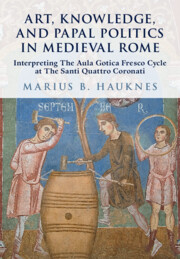Refine search
Actions for selected content:
3 results

Art, Knowledge, and Papal Politics in Medieval Rome
- Interpreting the Aula Gotica Fresco Cycle at Santi Quattro Coronati
-
- Published online:
- 30 January 2025
- Print publication:
- 30 January 2025
Chapter 8 - Remedies or Superstitions
- from Part II - The Borders of Pharmacology
-
-
- Book:
- Drugs in the Medieval Mediterranean
- Published online:
- 19 October 2023
- Print publication:
- 02 November 2023, pp 277-290
-
- Chapter
- Export citation
Chapter 11 - Lessons in the Distant Mirror of Medieval Physics
- from Part IV - Before Science and Religion
-
-
- Book:
- After Science and Religion
- Published online:
- 05 May 2022
- Print publication:
- 19 May 2022, pp 259-281
-
- Chapter
- Export citation
